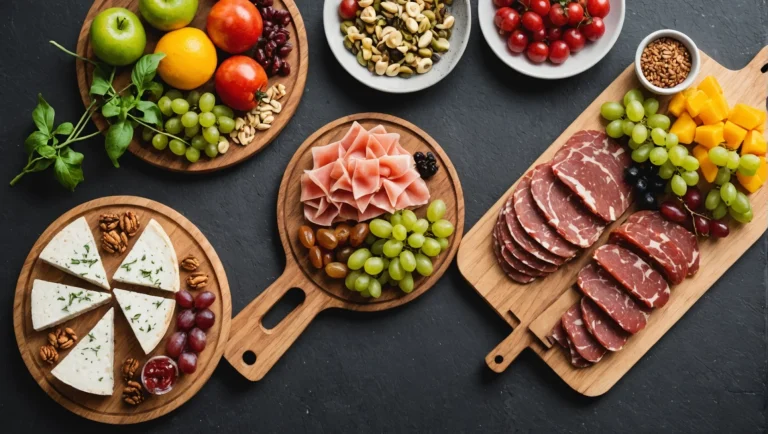Every restaurateur knows presentation is as crucial as the food served. But what about the choices between a charcuterie board and a cutting board for your business? This guide is here to help you grasp the key differences and benefits these two boards can offer. From boosting your dining experience with charcuterie to finding durable cutting boards for the kitchen, we cover it all. Enhance brand perception, increase profits, and maintain high safety standards—whatever your needs, this guide has insights.
Save 80% of delivery management time
We handle everything:
- Dedicated operations manager
- Real-time tracking dashboard
- Automated customer notifications
- Urgent issue resolution
Understanding the Key Differences: Charcuterie Board vs Cutting Board
A charcuterie board is more than just a serving tray. It showcases a selection of curated items like cured meats, cheeses, fruits, nuts, and bread. The goal is a stunning and tasty display. In our testing, we noticed a focus on elegance to elevate the presentation. Business settings often use these boards to impress guests with their look and the variety they offer. A good charcuterie board will enhance the visual appeal of any setting, making it a favorite in hospitality. Choosing the right materials for your charcuterie board is crucial in achieving an elegant appearance and showcasing your selections beautifully.
A cutting board, in contrast, is a workhorse in the kitchen. It’s a flat platform designed to take the brunt of chopping, slicing, and cutting. Its main purpose is utility. It protects countertops from knife marks and provides a more stable surface and work area. In kitchens and food prep areas, cutting boards are essential tools. They are designed to endure wear and tear. So, they prioritize strength overlooks.
Highlight The Main Differences Between Them in Terms of Use and Design
Charcuterie Boards: Ideal for dining table display. Not suited for cutting tasks. In our experiments, we found they excel in making food look appealing. Their materials and finishes focus on appearance rather than durability.
Cutting Boards: Serve the practical function of food prep. They are thick and durable to withstand daily use. They need regular maintenance due to wear from knives.
Ultimately, if you are looking for elegance and presentation, a charcuterie board stands out. For robustness and routine work, a cutting board takes the win. In terms of what’s best overall for business, charcuterie and serving boards also win for their blend of form and function. They add to the atmosphere and boost customer satisfaction. The next section will dive deeper into how these boards benefit the hospitality industry. Stay tuned for insights.
Benefits of Charcuterie Boards in Hospitality
Charcuterie boards boost visual appeal and customer satisfaction.
They increase potential revenue with creative upselling.
Enhance restaurant branding through thoughtful design.
Presentation and Experience
Charcuterie boards are visually stunning. Customers often choose where to dine based on what they see online first. Beautiful photos of restaurant dishes are shared on social media, attracting more guests. The colorful combination of cheeses, meats, and fruits creates a feast for the eyes. The experience doesn’t just stop at how the food looks. It also engages other senses—consider the aroma of cured meats and the texture contrast between a smooth cheese and crunchy nuts.
Customization is another key factor. Restaurants can adjust their charcuterie boards to fit different themes, events, and personal tastes. You can offer a “build-your-own” option. This makes the dining experience more interactive. When people feel engaged, their satisfaction rises. In turn, this can lead to higher tips, better reviews, and repeat visits.
Profitability and Upselling
Charcuterie cheese boards offer a great upselling opportunity. Because they are usually shared, they often encourage larger group orders. Restaurants can increase their average order value by suggesting wine or additional items that pair well with the good cheese board. A simple cheese board might lead to the sale of a premium aged wine.
Branding and Ambiance
Charcuterie boards can be designed to align with the overall theme of a restaurant. A rustic restaurant could use wooden boards, while a modern eatery might opt for sleek slate or marble. The board itself becomes a canvas that conveys a brand’s story and authenticity.
Food Pairing Expertise
Charcuterie boards allow chefs to exhibit their expertise in flavor pairing. The careful selection balances savory, salty, sweet, and tangy tastes for different purposes. Learning the art of pairing cheeses with fruits, nuts cold meats, and wines requires in-depth knowledge of culinary arts.
Running cheese classes or tasting events can make a restaurant a go-to spot for culinary experiences. This can also generate additional income while enriching the expertise of the staff.
Sustainability and Locally Sourced Ingredients
A charcuterie shop on board can spotlight local produce and sustainability. Sourcing local ingredients can lower carbon footprints and support community businesses. For customers, this often adds to the appeal and boosts their perception of the business’s values.
Integrating these aspects into your restaurant not only benefits the customer’s experience but also builds a stronger, more aligned brand. Everything from food preparation to presentation to sustainability comes together in a valuable way.
Choosing Cutting Boards for Commercial Use
Learn about durability, safety, and maintenance for cutting boards.
Compare materials like wood, plastic, and bamboo.
Get insights on health standards and cost-effectiveness.
Material Selection for Cutting Boards
Wood Cutting Boards
Wood cutting boards, especially those made from hardwoods like maple and walnut, are a top choice for commercial kitchens. They are often praised for their durability, achieving decades-long lifespans with proper care. This makes them a sturdier option as compared to plastic ones, which might need frequent replacements due to wear. Wood boards are also gentle on knife edges, which helps keep kitchen tools in optimal condition.
Plastic Cutting Boards
Plastic cutting boards are commonly found in commercial setups given their nonporous nature. They are easy to clean but must be replaced sooner when knife grooves deepen. Such grooves pose a risk, harboring harmful pathogens that threaten kitchen safety. You should consider materials like polyethylene and HDPE to enhance lifespan, corresponding with health and safety priorities.
A major benefit of plastic is its adaptability to color-coding. By assigning different colors and shapes to specific food types, such as raw meat and vegetables, a kitchen can effectively reduce cross-contamination risks. For a comprehensive overview of plastic cutting boards, “Food Safety for Managers” by Lisa Berger gives extensive insight into integrating various shapes of plastics into culinary contexts.
Bamboo Cutting Boards
Bamboo is a lightweight and eco-friendly alternative often regarded with mixed opinions. It is resistant to scratches, offering an undeniable advantage. However, concerns regarding adhesive elements and vulnerability to knife marks limit its commercial viability. They also absorb moisture more readily, demanding frequent checks and maintenance.
Health and Safety Standards
Hygiene is critical when choosing cutting boards. Using sanitary materials compliant with health regulations can minimize the risk of foodborne illnesses in busy kitchen environments. The U.S. Department of Agriculture (USDA) suggests that regular cleaning and thorough drying are essential.
For food service businesses, having an effective cleaning routine is vital. This involves using hot soapy water, with some boards benefiting from an occasional bleach treatment. Color-coded boards are another beneficial practice, allowing cross-contamination prevention.
Durability and Cost-Effectiveness
Durability and economics play a role when selecting cutting boards. High-quality boards, like those from hardwood or HDPE plastic, favor long-term investments due to their longevity. While they might have a higher upfront cost, they typically demand less frequent replacements, offering savings over time.
For those with budget constraints, lower-cost options are available, yet these may sacrifice durability. The trade-off between quality and affordability can spark debates about the ideal choice. Sorting such questions is vital and further detailed discussions can be found in the “Restaurant Success by the Numbers” by Roger Fields which covers integral cost choices in various types of the hospitality industry.
A steady maintenance approach can prolong the board’s usability, integrating routine cleaning and sanitization measures to extend its lifespan. Whether using high-end materials or more budget-friendly alternatives, evaluating the long-term costs relative to the initial investment proves crucial. It’s a balancing act between spending and return, mindful of the level of quality a commercial kitchen demands.
Types of Charcuterie Boards: Find the Right Fit for Your Business
Focus on different materials and styles.
Link boards to business needs.
Answer common questions about charcuterie boards.
Traditional Wooden Boards
Traditional wooden boards are classics in the world of charcuterie. They evoke a sense of warmth and craftsmanship and fit seamlessly into almost any environment, whether it’s a cozy café or a rustic bistro. Businesses that prioritize a homey, inviting experience often opt for these.
When selecting wooden boards, the type of wood and crafting method matter a lot—think of oak, walnut, or cherry. These varieties often hold up better over time while adding visual character. It’s helpful to check for boards that are handmade or crafted by reputable manufacturers, as mass-produced pieces might lack the durability and elegance needed for your client base.
Contemporary Stone or Slate Boards
Stone and slate boards cater to businesses aiming for a refined look. They offer an upscale appearance with functional benefits. Perfect for fine dining or wine bars, the glass and stone surfaces resist stains and present a flat surface with a minimalist look.
Stone and slate offer a sleek aesthetic that complements high-end ingredients. Their natural coolness prolongs the freshness of certain items, making them a smart and popular choice for serving cheese. While visually appealing, they are heavy and prone to chipping, so they require careful handling and storage. Businesses must weigh these factors against the board’s visual benefits.
Alternative Materials and Innovative Designs
Exploring materials beyond wood and stone sparks creativity. Acrylic, ceramics grain wood, and metals like copper or stainless steel offer distinct visual and tactile experiences.
Acrylic boards come in vibrant colors and patterns, making them ideal for modern, playful environments. Ceramic versions add a handcrafted charm but may break easily, while metal options are a modern, durable choice. You should evaluate your business environment—high turnover or frequent movement might favor metal over ceramic for longevity.
Addressing Key Questions: What Constitutes a Charcuterie Board?
A charcuterie board isn’t just a rectangular piece of servingware. At its core, it is a canvas—crafted to display a curated assortment of meats, cheeses, and often complementary items like nuts or fruits. Presentation is paramount, distinguished by arrangement style, grain pattern, texture contrast, and color balance. Whether you’re an enthusiast or a novice, find unique charcuterie board suggestions to elevate your next gathering with an impeccably styled and visually appealing selection.
What Does Not Belong On a Charcuterie Board?
While the rules for finger foods up for inclusion are not rigid, raw meat and pungent fish are usually left out due to food safety and flavor clash. Fresh fruits are a yes; canned or cooked fruits, are often a no. You can choose items that celebrate quality and enhance the eating experience.
Measure Your Match with Business Type
Selecting the right board goes beyond aesthetics—it’s about aligning with your brand identity and target customer preferences. For a hip, fast-casual setting, acrylic may offer the pop you need. Stone works wonders in upscale settings, while wood’s versatility suits a wide range.
Supplementary Information and FAQs
Charcuterie boards are popular and can be profitable.
Different cutting board materials suit various needs.
“Cutting board” and “charcuterie board” are not the same.
Are Charcuterie Boards a Good Business?
Charcuterie boards have become popular in recent years. They appeal visually and allow for creativity. Many businesses have turned this into a profitable venture. As Rachel Holkenbrink from Grazing Style Charcuterie Co. noted, starting small and growing through demand can lead to success. The demand for charcuterie boards stems from their use in events and gatherings. These boards showcase specialized meats, cheeses, and arrangements, creating a memorable dining experience. Thus, sourcing the right supplies for charcuterie is essential to enchant your guests and elevate any event.
It is better to consider market trends that show an increase in demand for mini and personalized versions. This could diversify offerings and tap into wider market segments. Adding unique features like themed boards or corporate event offerings could increase profitability. Sophia D, Founder of The Graze Academy, mentions the importance of add-ons, which enhance profitability by leveraging upsells like mocktails or floral arrangements. However, like any business, charcuterie boards have challenges. Overestimating demand leads to losses, while burnout is a common issue, especially if profits do not grow with the workload.
What are the 3 Types of Cutting Boards?
The three main cutting surface types are wood, plastic, and composite cutting boards. Each has specific uses for different functions and fits different industry needs. Upgrade your cheese cutting experience with a premium cheese slicer, tailored for effortless slicing on any board surface.
Wood Cutting Boards
Wood boards, made from hardwoods like maple or walnut, are known for their visual appeal. They work well in settings where aesthetics matter, like restaurant kitchens or chef presentations. The porous nature of wood means it can harbor bacteria if not maintained. They need regular oiling to remain in good shape.
Plastic Cutting Boards
Plastic cutting boards, often made from high-density polyethylene, are known for durability and ease of sanitation. They’re best for high-volume kitchens and are ideal for reducing cross-contamination through color coding. They have a short lifespan due to knife grooves. “Food Safety for Managers” is a good reference for best practices in using plastic boards.
Composite Cutting Boards
Composite boards are made from resin and wood fibers. They offer a balance between the durability of plastic and the look of wood. These boards perform well in cafes or small restaurants that require both function and style. They resist knife marks and are easier to clean, though they might not be as visually appealing.
Finding the right fit for your business involves assessing daily needs and practical applications. Evaluating whether the aesthetic quality or functionality is more critical will guide your choice.
What is the Proper Name for a Cutting Board?
The term “cutting board” is common, yet industry-specific names vary. For culinary use, “butcher block” implies a thick wooden board. For broader markets, “chopping board” is a common term. When related to charcuterie, terms like “platter” or “serving board” might apply.
Naming impacts customer perception and marketing. Descriptive and unique names can enhance brand appeal. For instance, a “grazing and serving platter” might convey a more luxurious offering than simply a cutting board. Customer perception can drive demand, connecting the product name with quality or exclusivity.
Industries aiming to attract specific audiences, such as high-end dining, might use terms like “artisan crafted” for effect.
With an understanding of different boards and effective naming, businesses are better positioned in the culinary space. This knowledge equips owners to diversify offerings and optimize branding.
Choosing the Right Boards for Your Business
Charcuterie boards wow customers with their presentation and boost restaurant branding, while cutting boards emphasize durability and hygiene in commercial kitchens. Charcuterie and rectangular cutting boards can elevate dining experiences and increase profitability. The right cutting board material ensures safety and cost efficiency.
Think about whether your focus should be on enhancing customer experience with charcuterie offerings or maximizing kitchen efficiency with reliable cutting boards. You should assess your current presentation and see if there’s room for charcuterie options. You can evaluate your cutting board’s durability and hygiene practices.














